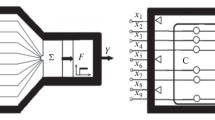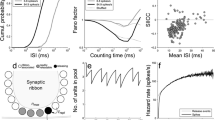Summary
-
1.
Some visual interneurons in the medulla of the locust (Locusta migratoria) optic lobe, give highly phasic responses, typically a single spike, to any suprathreshold intensity change. Although forming a distinctive class, these cells vary in receptive field area and their relative sensitivities to intensity increments and decrements.
-
2.
The timing of responses is quite precise. Typically the standard deviation of the spike latency is 2 ms. The responses to intensity increments and decrements are very similar in waveform and latency, so the cells not signal stimulus polarity. Spike timing depends upon stimulus contrast, below contrasts of about 0.4.
-
3.
Spiking responses adapt so that cells do not give a steady state response to stimulus frequencies of over 10 Hz. Graded potential responses to sinusoidal flicker exhibit a powerful second harmonic component.
-
4.
A description is given of a simple way in which the responses of this group of cells can be obtained by linear and nonlinear operations on the photoreceptor input.
Similar content being viewed by others
References
Barlow HB, Levick WR (1969) Three factors limiting the reliable detection of light by retinal ganglion cells of the cat. J Physiol 200:1–24
Bishop LG, Keehn DG (1966) Two types of neurones sensitive to motion in the optic lobe of the fly. Nature 212:1374–1376
Burr D, Ross J (1979) How does binocular delay give information about depth? Vision Res 19:835–837
Campos-Ortega JA, Strausfeld NJ (1972) Columns and layers in the second synaptic region of the fly's visual system: The case for two superimposed neuronal architectures. In: Wehner R (ed) Information processing in the visual system of arthropods. Springer, Berlin Heidelberg New York, pp 31–36
DeVoe RD (1980) Movement sensitivities of cells in the fly's medulla. J Comp Physiol 138:93–119
DeVoe RD, Ockleford EM (1976) Intracellular responses from cells of the medulla of the flyCalliphora erythrocephala. Biol Cybern 23:13–24
Honegger HW (1978) Sustained and transient responding units in the medulla of the cricketGryllus campestris. J Comp Physiol 125:259–266
Honegger HW (1980) Receptive fields of sustained medulla neurons in crickets. J Comp Physiol 136:191–201
Horridge GA (1978) The separation of visual axes in compound apposition eyes. Phil Trans R Soc Lond B 285:1–59
Howard J (1981) Temporal resolving power of the photoreceptors ofLocusta migratoria. J Comp Physiol 144:61–66
Laughlin SB (1981) A simple coding procedure enhances a neuron's information capacity. Z Naturforsch 36c:910–912
Laughlin SB (1984) The roles of parallel channels in early visual processing by the arthropod compound eye. In: Ali MA (ed) Photoreception and vision in invertebrates. Plenum, New York, pp 457–481
Levick WR (1973) Variation in the response latency of cat retinal ganglion cells. Vision Res 13:837–853
Osorio D (1986a) Ultraviolet sensitivity and spectral opponency in the locust. J Exp Biol 122:193–208
Osorio D (1986b) Directionally selective cells in the locust medulla. J Comp Physiol A 159:841–847
Osorio D (1987) Temporal and spectral properties of sustaining cells in the medulla of the locust. J Comp Physiol A 161:441–448
Pinter RB (1972) Frequency and time domain properties of retinular cells of the desert locust (Schistocerca gregaria) and the house cricket (Acheta domesticus). J Comp Physiol 77:383–397
Reichert H, Rowell CHF, Griss C (1985) Course correction circuitry translates feature detection into behavioural action in locusts. Nature 315:142–144
Rowell CHF (1971) The orthopteran descending movement detecting (DMD) neurons: A characterisation and review. Z Vergl Physiol 73:167–194
Rowell CHF, O'Shea M, Williams JLD (1977) The neuronal basis of a sensory analyser, the acridid movement detector system. IV. The preference for small field stimuli. J Exp Biol 68:157–185
Sherwood SL (1966) The nature of psychology. A selection of papers, essays and other writings by the late Kenneth JW Craik. Cambridge University Press, Cambridge
Strausfeld NJ (1976) Atlas of an insect brain. Springer, Berlin Heidelberg New York
Wiersma CAG, Roach JLM, Glantz RM (1982) Neural integration in the optic system. In: Atwood HL, Sandeman DC (eds) The biology of Crustacea, vol 4. Academic Press, New York, pp 1–31
Wilson M (1975) Angular sensitivity of dark and light adapted locust retinula cells. J Comp Physiol 97:323–328
Author information
Authors and Affiliations
Rights and permissions
About this article
Cite this article
Osorio, D. The temporal properties of non-linear, transient cells in the locust medulla. J. Comp. Physiol. 161, 431–440 (1987). https://doi.org/10.1007/BF00603968
Accepted:
Issue Date:
DOI: https://doi.org/10.1007/BF00603968




